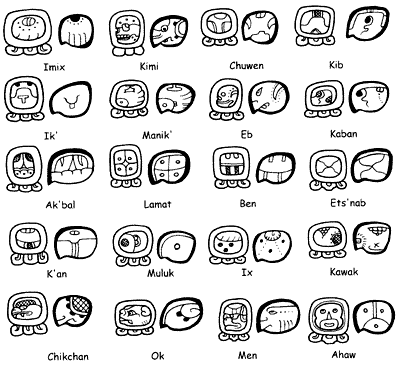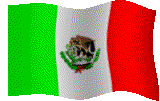|

The
twenty days of the Tsolk'in, shown above by
name and with 2 versions of their corresponding glyphs,
are the basis of the entire complicated calendrical system
designed by the ancient Maya. They are, however,
by no means to be considered as abstract computational units.
Rather they reflect the physical properties and the origin
of man as well as the influence which powerful celestial
beings, in particular the moon and the sun, have on his
existence. Twenty is the total number of human extremities,
fingers and toes, and is contained 13 times in 260, the
duration of the divinatory calendar, the Tsolk'in.
This time-period (plus one day) actually represents nine
lunations of twenty-nine full day-and-night cycles. As is
well known, the time between menstruations is one lunation,
and it takes nine of these anthropo-lunar cycles for a new
human being to form after impregnation.
Among the Quiché-Maya of highland Guatemala
these same nine months are replicated, until this very day,
in the training of the aj k'ij, the keeper
of the 260-day-calendar, the ah k'in of ancient Yucatán.
 It
is nine months after the beginning of training in divination
that the young novice is actually "born" and solemnly
initiated into his office. Thus, in the perception of the
Maya, man and calendar have the same roots; they are both
of the same lunar origin. This is how Quiché-Maya
calendar-priests explained it to the German physician
and ethnologist Dr. Leonhard Schultze Jena back in 1930.
Here is Dr. Leonhard Schultze Jena at work in his library
at Marburg, Germany, towards the end of WW II, presumably
some time during 1944. Foto: Kohlhammer Press, Stuttgart/Berlin It
is nine months after the beginning of training in divination
that the young novice is actually "born" and solemnly
initiated into his office. Thus, in the perception of the
Maya, man and calendar have the same roots; they are both
of the same lunar origin. This is how Quiché-Maya
calendar-priests explained it to the German physician
and ethnologist Dr. Leonhard Schultze Jena back in 1930.
Here is Dr. Leonhard Schultze Jena at work in his library
at Marburg, Germany, towards the end of WW II, presumably
some time during 1944. Foto: Kohlhammer Press, Stuttgart/Berlin
It
is, therefore, not surprising to find that the Maya
considered the days of their calendar to be living beings,
albeit of a different, a more powerful and influential nature.
People were named just after "the lord of the day"
who ruled on the day they were born. The two kings who ruled
the Quiché-Maya when the Spaniards under Alvarado
conquered Guatemala in 1524, had calendar-names. They were
named Oxib Quieh ( "3 Deer" = Oxil
Manik' in Yucatec Maya ) and Beleheb Tzi (
"9 Dog" = Bolon Ok in Yucatec Maya
).
|

 It
is nine months after the beginning of training in divination
that the young novice is actually "born" and solemnly
initiated into his office. Thus, in the perception of the
Maya, man and calendar have the same roots; they are both
of the same lunar origin. This is how Quiché-Maya
calendar-priests explained it to the German physician
and ethnologist Dr. Leonhard Schultze Jena back in 1930.
Here is Dr. Leonhard Schultze Jena at work in his library
at Marburg, Germany, towards the end of WW II, presumably
some time during 1944. Foto: Kohlhammer Press, Stuttgart/Berlin
It
is nine months after the beginning of training in divination
that the young novice is actually "born" and solemnly
initiated into his office. Thus, in the perception of the
Maya, man and calendar have the same roots; they are both
of the same lunar origin. This is how Quiché-Maya
calendar-priests explained it to the German physician
and ethnologist Dr. Leonhard Schultze Jena back in 1930.
Here is Dr. Leonhard Schultze Jena at work in his library
at Marburg, Germany, towards the end of WW II, presumably
some time during 1944. Foto: Kohlhammer Press, Stuttgart/Berlin
